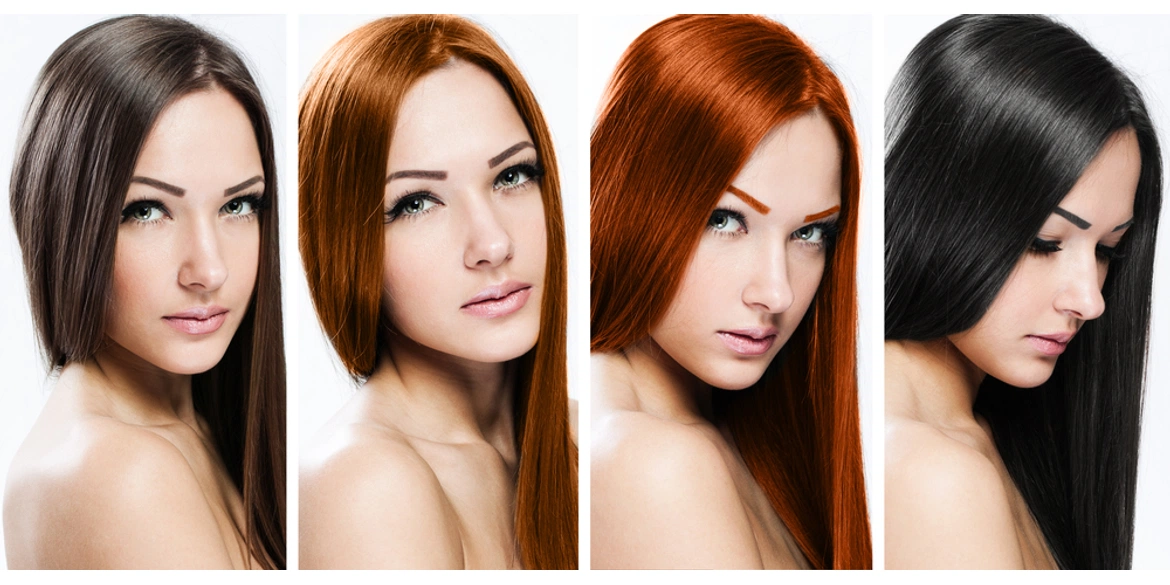
Natural Dyes & Hair: The Art & Science of Hair Colouring
A series on Hair Care:
Hair types, different types of natural hair dyes and the effect it can have on your hair as per your hair structure
by Ms Maushumi Thakurta of MrilQ Cosmeceuticals
I am often bombarded with the same question; will Henna leave an orange tint to my hair?
Should I add egg or curd to my Henna?
Why does my scalp itch when I apply Henna?
Hair is made of a protein called Keratin. Hair is a derivative of the epidermis (outermost part of the skin) and consists of two distinct parts: the follicle (The opening from which the hair length comes out of the skin) and the hair shaft (The structure we see outside the skin).
The follicle is the essential unit for the generation of hair - BLOCKED or infected hair follicles result in, hair fall, greying, dry & frizzy hair, bald patches etc.
The hair shaft consists of a cortex and cuticle cells, and a medulla for some types of hairs.
Natural Dyes obtained from plant material, have a bigger molecular structure. They work on the Hair Shaft. (Outer layer of the hair) and NOT ON THE CUTICLE (the core of the hair). Chemical dyes work on the Cuticle of the hair.
Pure Natural dyes not only COLOUR the hair, but they also exfoliate the scalp and nourish the hair follicles which in turn helps to improve the quality of the hair. It controls dandruff & hair fall and improves hair volume.
Unlike chemical colours where every HAIR TYPE gets the same colour (as they bleach the natural hair pigment melanin from the hair), Natural colours leave a DIFFERENT COLOUR IMPRESSION on different individuals. The “Colour Impression” is totally dependent on the
- Your Natural Hair Colour
- If the hair has been chemically treated (Protein or Keratin treatment, straightening/ perming, chemical dyes, Chemotherapy, use of strong medication for treatments)
- Hair structure & porosity
- Scalp condition (Oily/ Dry/ Infected)
Note: Repeated and frequent application of Natural Hair Dyes will result in achieving YOUR DESIRED COLOUR.
Colouring hair with Henna or Lawsonia inermis – Part 1
Henna has been used for centuries for colouring hair. It is a good hair conditioner and scalp exfoliator.
The Orange/Copper DYE is present only in Henna Leaves and in no other part of the plant.
“Black Henna”: Even in powder form contains a chemical called PPD (Paraphenylenediamine) a chemical present in chemical dyes.
The particular molecule in the Henna plant’s leaves that allows it to be used as a dye is lawsone, also known as hennotannic acid.
“Lawsone” alone, leaves a very light colour on Keratin (the skin or hair protein). “Henna or lawsone” gives the best colour when mixed with a slightly acidic solution
This preparation is necessary because lawsone isn’t present as a free molecule in henna leaves, but is derived from compounds called hennosides. The mild acidic conditions and subsequent oxidation used in preparing the dye bring about this transformation.
Option 1:
- Natural Hair Colour: 70% Black or Brown with 30-35% Grey
- Hair structure & porosity: Medium thickness (refers to each hair thickness & not overall volume of hair)
- Scalp condition: On the dry side
Probable colours & Shades obtained:

Copper Brown (If hair is around 35% Grey)

Blackish Golden brown with repeated two to three application, (if hair is 50% grey)

Streaks of Brown (If hair is 55 % Grey)

Yellowish Golden Brown (If hair is around 65% Grey with Cassia & Marigold)


Marigold Brown or Golden Brown (If hair is 90% Grey with Cassia & Marigold)
Suggested combinations:
1) Lemon Juice: Lemon juice has a pH of around 2-2.3, containing Citric acid , is very acidic. Henna/lime juice mix will give a very light orangish/yellowish tone first to the grey but with darken within a few days. Repeated application will impart a strong dark colour. Mix lemon juice in Henna and leave it overnight for a “Hydrogen Rich paste”.
The black hair would be darker & shiny
Note:
- Dilute the lemon Juice with lukewarm water before mixing with henna
- After rinsing the Henna mixed with lemon Juice you get a “Dry/ Crunchy feeling’ to the hair (It happens because the keratin in your hair gets raised up to bind with the Lawsone in Henna). Do not worry. Your hair is NOT DAMAGED. Apply three to four drops of coconut oil with three to four drops of water on the washed hair. Leave it, and your hair will be normal soon.
2) Vinegar: With a pH of around 2.4 to 2.6, containing acetic acid, gives a light brown colour and with time the colour changes to dark brown. Gives a lovely sheen to the hair.
Dilute the Vinegar with Room Temperature water and leave it overnight before application.
3) Apple Juice: (the best suggested acidic medium) : with a pH of around 3.5, apple juice contains Malic acid, which when mixed with henna, makes your hair soft & silky with a soft brownish yellow tinge to the hair, that will darken with time & repeated application.
Preferable water for Mixing Henna
Tap water is NOT SUGGESTED for mixing Henna as it is highly alkaline with dissolved salts. As the RAINY SEASON is fast approaching, collect some rain water (especially in METRO CITIES where the rain water is more acidic) and use it for mixing your Henna for getting a darker shade which retains longer.
Pure Henna or Pure Henna with a few other active botanicals can be easily applied on hair which has been chemically treated (Protein or Keratin treatment, straightening/ perming, chemical dyes, Chemotherapy, use of strong medication for treatments), to improve its quality.
Click here to buy the MrilQ Color Charisma Kit from Pracol
#NaturalHairDyes #GreenBeautyMovement #Wellness #TheCrowningGlory #Wellness #SafeHairColours #MrilQMagic #ColourCharisma #HappyHairMoments #Love
